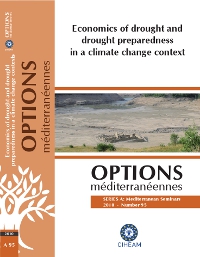| Article précédent | p. 273-278 | Article suivant |
The role of Dryland Agricultural Research Institute in drought mitigation in Iran
Although drought is a natural hazard, the term drought management and action plans imply that human intervention can reduce vulnerability and impacts. To be successful in this endeavor, many disciplines must work together in tackling the complex issues associated with detecting, responding to, and preparing for the inevitability of future events. Disaster management, of which drought management is a subset, requires scientists and policy makers to focus on both the protection and recovery/rehabilitation of drought. In the past, the emphasis in disaster management has been placed largely on the response and recovery portion of drought management, with little or no attention to mitigation, preparedness, and prediction and monitoring. The Dryland Agricultural Research Institute (DARI), in Iran mainly focused on the breeding crops for drought tolerance, soil management to conserve moisture (minimum tillage, crop rotation, etc.), supplementary irrigation, water harvesting, and agro-ecological zoning considered as basic activities that should be strengthened to cope with drought in the future.
Bien que la sécheresse soit un aléa naturel, les termes gestion de la sécheresse et plans d'action impliquent que l'intervention humaine peut en réduire la vulnérabilité et les impacts. Pour y réussir, plusieurs disciplines doivent travailler de concert pour aborder les questions complexes liées à sa détection, pour réagir et se préparer à l'inévitabilité des événements futurs. La gestion des catastrophes, dont fait partie la gestion de la sécheresse, nécessite que scientifiques et décideurs se focalisent à la fois sur la protection et la récupération/réhabilitation lors de la sécheresse. Dans le passé, l'accent était largement mis sur le volet réponse et récupération à la sécheresse, celui sur l'atténuation, la prévention, la prévision et la surveillance ne faisait l'objet que d'une attention réduite ou nulle. L'Institut pour la Recherche Agronomique en Zones Arides (DARI), en Iran, est principalement axé sur l'amélioration des cultures pour la tolérance à la sécheresse, sur la gestion du sol pour conserver son humidité (labour minimum, rotation des cultures, etc.), sur l'irrigation d'appoint, la collecte d'eau, et le zonage agroécologique, considérés comme activités fondamentales devant être renforcées pour lutter contre la sécheresse dans le futur.
- [ Afficher ]
- [ Télécharger ]
- [ Exporter la citation ]
Vous pouvez télécharger la citation au format :
- [ Imprimer ]
-
Mots-clés
INSTITUTION, IRAN REPUBLIQUE ISLAMIQUE, MEILLEURE PRATIQUE, PRATIQUE AGRICOLE, SECHERESSECiter cet article
Ghaffari A. The role of Dryland Agricultural Research Institute in drought mitigation in Iran. In : López-Francos A. (comp.), López-Francos A. (collab.). Economics of drought and drought preparedness in a climate change context. Zaragoza : CIHEAM / FAO / ICARDA / GDAR / CEIGRAM / MARM, 2010. p. 273-278. (Options Méditerranéennes : Série A. Séminaires Méditerranéens; n. 95). 2. International Conference on Drought Management, 2010/03/04-06, Istanbul (Turkey). http://om.ciheam.org/om/pdf/a95/00801356.pdf



